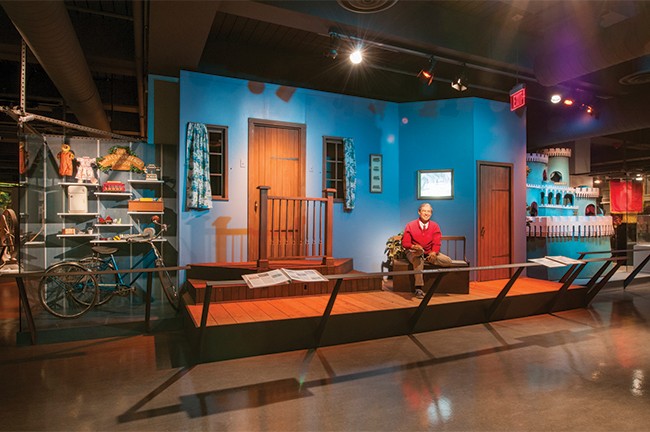Long synonymous with the black fog of its signature steel, coal and oil industries, Western Pennsylvania's environmental transformation is a shining inspiration for the ages. Now at the forefront of sustainable development, the region continues to garner national acclaim for its pioneering accomplishments in green building, urban forestry and land conservation. With abundant all-natural outdoor opportunities besides, the green light is on for group agendas built around fresh ideas and reinvention.
Pittsburgh
No longer "hell with the lid taken off," today the Steel City is among the nation's greenest cities and the global leader in total green real estate.
Among the most visible successes is the David L. Lawrence Convention Center (DLCC), which became the world's first "green" convention center after earning LEED Gold certification following its 2003 opening. This year, the DLCC went Platinum—the highest LEED certification available—making it the world's first convention facility with these dual LEED honors.
Built on a former brownfield site along the Allegheny River in the heart of downtown, the 1.5 million-square-foot DLCC is a beauty to behold, its cable-suspended curving stainless steel roof structurally inspired by Pittsburgh's historic "Three Sisters" bridges. Already growing vegetables in its rooftop garden, the center has just opened a new event programmable 20,000-square-foot green roof, Monarch butterfly waystation included, offering dramatic cityscape and river views.
Handsome, too, is the DLCC's economic contribution to the city.
"Between 2006 and 2011, more than 110 groups chose the DLCC, citing the green element as a deciding factor," says Craig Davis, president and CEO of VisitPittsburgh. "Pittsburgh's leadership in the green movement and the green meetings industry is a distinct competitive advantage for booking meetings and conventions."
In a groundbreaking study benchmarking the DLCC's performance against other centers, a local consulting firm found that these green-seeking events generated approximately $176 million in direct spending for the Pittsburgh region. From the eco-friendly August Wilson Center for African American Culture to the new CONSOL Energy Center, the first LEED-certified NHL arena, green is the name of the game in Pittsburgh.
Take PNC Park, home of the Pittsburgh Pirates. Perfect for groups with its intimate feel and breathtaking cityscape backdrop, it is also a recognized eco-leader. Launched in 2008, the club's "Let's Go Bucs. Let's Go Green" program integrates greening initiatives, sustainable business practices and educational outreach.
"In the last four years, our rate for diverting waste materials from traditional disposal has jumped from 27 percent to 67 percent," says Robert Nutting, owner and chairman of the Pittsburgh Pirates. "Environmental responsibility is an area I personally take very seriously, and I am proud of what all of our green-focused programs and initiatives continue to achieve."PageBreak
Another green guardian is Richard Piacentini, executive director of the Phipps Conservatory and Botanical Gardens. One of the city's crown jewels, "The Green Heart of Pittsburgh," is an Industrial Age vestige now defining the very future of sustainability. For its pioneering commitment to the green movement, the White House selected the Phipps to host several key events during the 2009 G-20 Summit, including a luncheon attended by President Obama and other world leaders.
"Our LEED-certified welcome center is the first in a public garden, while our Tropical Forest Conservatory is the most energy-efficient in the world," Piacentini told me as we toured the facility's many attractive group and event spaces.
Most exciting of all is the Phipps' nearly complete Center for Sustainable Landscapes, a completely self-sustaining building destined to be among the greenest structures on Earth.
"Seeking to achieve or exceed the world's highest sustainable standards, this will be an innovation for the world," Piacentini says.
The eco-story continues downtown, where PNC Bank has broken ground on a new world headquarters tower designed to be the world's greenest skyscraper. Just a block away, the 185-room Fairmont Pittsburgh, with a Gold rating, is the first LEED-certified hotel in the Fairmont portfolio.
Offering 12,000 square feet of meeting space, the hotel features green design and practices throughout, with 75 percent natural lighting, water conserving systems and myriad other eco-friendly credentials. Impressive, too, are the displays of glass bottles, doll heads and other 19th century artifacts recovered by archeologists during the 2007 excavation of the building site.
With other green group facilities that include the Children's Museum of Pittsburgh and Senator John Heinz History Center, green has joined Steeler black and gold among the city's signature colors.
"If you want to have a green meeting, all you have to do is show up in Pittsburgh," Davis says.
Butler County
The green theme continues in the scenic region directly north of Pittsburgh and Allegheny County, where some 2,000 hotel rooms support a diverse range of group facilities.
"Reflecting the unique make-up of our county businesses, we offer a fresh look at meeting facilities," says Amy Pack, director of tourism development for the Butler County Tourism and Convention Bureau.
This includes a number of green meeting venues, such as the LEED Silver NC-certified Regional Learning Alliance in Cranberry Woods. Abundant windows admit natural light galore, enhancing the award-winning conference facility's reputation for productive business and educational gatherings. At Slippery Rock University, the new 106,000-square-foot Robert M. Smith Student Center, built to LEED Silver standards, offers space to outside educational groups. In Butler, meanwhile, planners can utilize the green-designed auditorium and conference space at Butler Health Systems' new Patient Tower.
Indiana County
Located in the foothills of the Allegheny Mountains one hour east of Pittsburgh, this scenic heritage escape is recognized for its abundant Christmas tree farms and traditional Amish communities. Long before green became the byword for eco-conscious practices, the Amish were perfecting sustainable agrarianism. Today, utilizing thousands of acres of farmland across the county, Amish and modern-day farmers alike rely on organic, hydroponic and greenhouse techniques to produce fruits, vegetables and dairy products. Groups can savor the bounty via the county's extensive Farm to Table program, while also visiting its many wineries. With an extensive network of parks and trails, Indiana County is also ideal for outdoor adventures.
Monroeville
Located 12 miles east of downtown Pittsburgh, the Monroeville Convention Center comes with a newly renovated, 191-room Doubletree Hotel on-site and 1,800 free parking spaces. Focused on green meetings and with LEED certification pending, the 100,000-square-foot facility's heating and cooling system uses 20 percent less energy than conventional systems, while its white roof helps the cooling by reflecting sunlight.
Suburban Monroeville also features more than 650 acres of parkland, with Boyce Park Nature Center among a number of local parks offering rental facilities.
In nearby Braddock, groups have a remarkable opportunity to experience a signature icon of Pittsburgh's industrial past. Once the heart and soul of Andrew Carnegie's U.S. Steel's Homestead Works, the Carrie Furnaces National Historic Site complex is a rare and riveting example of pre-World War II iron-making technology. Led by the men who once prepared the molten iron that made the steel that built America, guided tours are available by appointment (www.riversofsteel.com) from May to October. PageBreak
Washington County
Located in the county seat of Washington, the Pennsylvania Trolley Museum is a showcase in the use of renewable energy. In 2009, the venue built a photovoltaic solar array on its roof to offset energy costs and power some of its vintage electric railway vehicles. Saving an estimated $5,000 per year on electricity costs, the "Solar-Powered Streetcar Project" has also saved some 190,000 pounds of carbon dioxide to date. The museum, which opened new event space for 85 guests last year, also uses its solar success as an educational tool for schoolchildren and visitors.
"This award-winning project was the first in North America to showcase solar-powered electric transit vehicles," says J. R. Shaw, executive director of the Washington County Tourism Promotion Agency.
Groups can also gather at any of Washington County's 23 covered bridges, most of which are located in local parks with pavilions and gazebos for rent, along with plenty of green space for team-building exercises, meals and receptions.
Laurel Highlands/Johnstown
With over 200,000 acres of preserved open green space, including multiple state parks and deep gorges and valleys, this three-county region southeast of Pittsburgh is an all-natural outdoor draw.
"Our signature activities include white-water rafting on the Youghiogheny River, hiking and biking along the 150-mile Great Allegheny Passage trail, and skiing at Pennsylvania's highest mountains," says Julie Donovan, spokeswoman for the Laurel Highlands Visitors Bureau.
Home to the Flight 93 National Memorial, the region also boasts three Frank Lloyd Wright homes. Privately owned Kentuck Knob includes the Nextoknob rental space, while close to iconic Fallingwater, the Silver LEED-certified, green-powered Barn at Fallingwater offers unique meeting space. Wright's Duncan House, meanwhile, offers overnight accommodations along with meeting space.
Celebrating its 25th anniversary this year, the 2,000-acre Nemacolin Woodlands Resort in Farmington comes with flexible space for a wide range of business and social gatherings along with six lodging options, including the Forbes Five-Star, AAA Five-Diamond Falling Rock boutique hotel.
To the northeast of the Laurel Highlands, former steel city Johnstown offers plentiful outdoor options for groups, including white-water rafting, kayaking, tubing and fishing. PageBreak
Erie
Sandy beaches, stunning sunsets and endless outdoor recreation make 3,200-acre Presque Isle State Park, a National Natural Landmark, one of Pennsylvania's top year-round vacation spots. Dubbed the "Gateway to Presque Isle," the Tom Ridge Environmental Center (TREC) is a state-of-the-art green interpretive facility offering interactive exhibits, public programs and The Big Green Screen, a four-story-high, 45-foot-wide theater.
Other green attractions include Asbury Woods Nature Center and the Erie Art Museum. Following an expansion project to tie together five historically significant buildings housing the Museum and the Erie County Historical Society, the venue now incorporates the city's first LEED-certified building. Also featuring Erie's first green roof, the museum hosted an event this summer called "The Art of Being Green: Is LEED worth it?"
For Western Pennsylvania, the answer would seem to be a resounding yes.
Regular Meetings Focus East contributor Jeff Heilman's visit to Pittsburgh as part of this assignment was an invigorating and inspiring breath of fresh air from start to finish.







